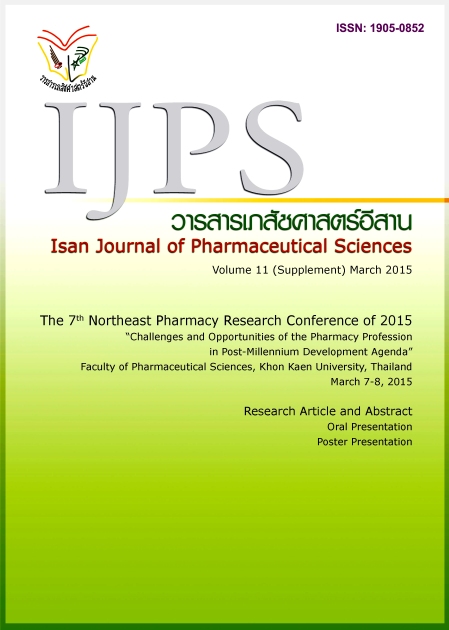The Development of Melatonin Mucoadhesive Film for Buccal Delivery
Main Article Content
Abstract
Introduction: The development of melatonin mucoadhesive film has the objective for delivering melatonin into systemic circulation through buccal mucosa. The bilayer composite film composed of the hydrophilic layer which includes 1.5% hydroxypropyl methylcellulose, 0.5% sodium alginate and 0.5% polyvinylpyrrolidone as film formers; glycerin and propylene glycol as plasticizers and permeation enhancers; and chitosan as a mucoadhesive polymer adhere to the hydrophobic layer. Materials and Method: The film was prepared by pouring polymer solution on the mold and casting the dry film from the mold. The physical properties of the film were evaluated by texture analyzer. The in vitro trans-mucosa absorption of melatonin through pig esophageal membrane that represents buccal mucosa was performed by using Franz diffusion cell and melatonin content was analyzed by HPLC. Results: The addition of glycerin into the film make the film softer and improve elasticity by decrease tensile force and increase percent elongation when compared with the film with propylene glycol or without plasticizers. Transmucosa absorption of melatonin in the films composed of chitosan together with plasticizers like glycerin and propylene glycol were more than the film without chitosan. Moreover, the rate of absorption was depended on the concentration of plasticizer in the film especially increasing concentration of propylene glycol in the film resulted in increasing permeation. Conclusion: Glycerin improved the softness and elasticity of the film while propylene glycol provided high permeability and diffusion coefficient. Altogether, the melatonin film properties were improved to achieve our goal
Article Details
In the case that some parts are used by others The author must Confirm that obtaining permission to use some of the original authors. And must attach evidence That the permission has been included
References
Benes, L., Claustrat, B., Horriere, F., Geoffriau, M., Konsil, J., Parrott, KA., DeGrande, G., McQuinn, Rl., and Ayres, JW. (1997). Transmucosal, oral controlled-release, and transdermal drug administration in human subjects: a crossover study with melatonin. J Pharm Sci. 86, 1115-1119.
Berra, B., and Rizzo, AM. (2009). Melatonin: circadian rhythm regulator, chronobiotic, antioxidant and beyond. Clinics in Dermatology. 27, 202-209.
Consuelo, ID., Falson, F., Guy, RH., and Jacques, Y. (2007). Ex vivo evaluation of bioadhesive films for buccal delivery of fentanyl. J Controlled Release. 122, 135-140.
Consuelo, ID., Pizzolato, GP., Falson, F., Guy, RH., and Jacques, Y. (2005). Evaluation of pig esophageal mucosa as a permeability barrier model for buccal tissue. J Pharm Sci. 94, 2777-2788.
Fourtillan, JB., Brisson, AM., Gobin, P., Ingrand, I., Decourt, JP., and Girault, J. (2000). Bioavailability of melatonin in human after day-time administration of D7melatonin. Biopharm Drug Dispos. 21, 15-22.
Galey, WR., Lonsdale, HK., and Nacht, S. (1976). The in vitro permeability of skin and buccal mucosa to selected drugs and tritiated water. JInvest Dermat. 67, 713-717.
Hafner, A. Lovric, J., Voinovich, D., and Filipovic-Grcic, J. (2009). Melatonin-loaded lecithin/chitosan nanoparticles: physicochemical characterization and permeability through Caco-2 cell monolayers. Int J Pharm. 381, 205-213.
Hoogstraate, JAJ., and Wertz, PW. (1998). Drug delivery via the buccal mucosa. Pharmaceutical Sciences & Technology Today, 1, 309-316.
Khan, TA., Peh, KK., and Ch’ng, HS. (2000). Mechanical, bioadhesive strength and biological evaluations of chitosan films for wound dressing. J Pharm Pharmaceut Sci. 3, 303-311.
Lin, J., Zhang, C., Cao, Y., Zhao, X., and Li, X. (2012) A validated method for determining melatonin in capsule dosage form. Spatula DD. 2, 147-151.
Mao, S., Chen, J., Wei, Z., Liu, H., and Bi, D. (2004). Intranasal administration of melatonin starch microspheres. Int J Pharm. 272, 37-43.
Patel, VF., Liu, F., and Brown, MB. (2011). Advances in oral transmucosal drug delivery. J Controlled Release. 153, 106-166.
Peh, KK., and Wong, CF. (1999). Polymeric film as vehicle for buccal delivery: Swelling, mechanical, and bioadhesive properties. J Pharm Pharmaceut Sci. 2, 53-60.
Reiter, RJ., (2003). Melatonin: clinical relevance. Best Practice & Research Clinical Endocrinology and Metabolism. 17, 273-285.
Revell, VL., Burgess, HJ., Gazda, CJ, Smith MR., Fogg, LF., and Eastman, CI. (2006). Advancing human circadian rhythms with afternoon melatonin and morning intermittent bright light. J Clin Endocrinol Metab. 91, 54-59.
Salamat-Miller, N., Chittchang, M., and Johnston, TP., (2005). The use of mucoadhesive polymers in buccal drug delivery. Adv Drug Delivery Reviews. 57, 1666-1691.
Shojaei, AH. (1998). Buccal mucosa as a route for systemic drug delivery: a review. J Pharm Pharmaceut Sci. 1, 15-30.


